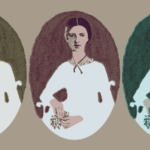You’re a detective.
The facts of the case are laid out before you: A body found floating in the river. Female, approximately 45 years old, five feet three inches in height. Trauma to the head, apparently from a blunt object. Coroner initially suspects foul play, but later revises his conclusion. The death is ruled accidental.
Maybe. But there are threads here to be pulled. The husband was having financial troubles. His wife, he claims, had lately fallen into “melancholia” and shown “signs of temporary insanity”; when she went missing the day previous, he feared she had taken her own life. It’s only after the deceased is identified, and the husband offers his theory of suicide, that the medical examiner decides the death isn’t suspicious after all. The blunt force trauma to the head, it is now suggested, was possibly caused by the wheel of a paddleboat.
You’re a ghost-hunter.
The newspaper is filled with stories of hauntings. A boarding house here, a townhouse there. Often, the tone of the article is wry, even slightly mocking. Sometimes, though, the story is deadly serious. The reporter is clearly unnerved by what he’s seen and heard. These are the accounts that strike you. Where everyone involved – not just the witnesses, but the police and the newspapermen too – are shaken to the core. You try to find out all you can about these cases, though it’s usually not much. The witnesses are long dead, the buildings razed to the ground. If you’re lucky, you find multiple articles about the same incident. Most of the time, though, you have only a single account, sealed in century-old ink. You set the most intriguing of these aside.
You’re a historian.
You’ve collected an impressive body of research materials: Biographies and memoirs, scholarly articles, newspaper clippings, websites of your fellow enthusiasts. You spend a lot of time browsing, in person or virtually, through the archives of libraries big and small. Meanwhile, you binge on every movie, TV show, and novel you can find about the period, soaking up details and atmosphere. How people dressed. What they ate. How they got around. Maybe you buy a book on historical slang. You find yourself babbling excitedly when you walk down the street, pointing out locations and regaling your bemused partner with historical minutiae.
You’re a novelist.
You take what you’ve learned from these three points of view – the detective, the ghost hunter, and the historian – and you weave it all together into a deliciously spooky historical mystery.
At least, that’s what I did when I was researching Murder on Millionaires’ Row, a Gilded Age mystery with a paranormal twist. And though it’s fair to say I was making it up as I went along, I managed to stumble across a pretty solid formula for exploring the intersection between mystery, historical fiction, and the supernatural.
But wait, you say. Isn’t this all a bit … vague? Where do you actually start? With the history, the mystery, or the supernatural? What’s the spark that sets the whole thing off?
Look around, and you’ll find examples of authors reaching the same intersection from a variety of different paths.It is vague, and that’s the beauty of it: I don’t think there’s a set answer. Look around, and you’ll find examples of authors reaching the same intersection from a variety of different paths. It all depends on what gets your motor running in the first place.
Maybe you’re interested in a particular time and place, as Nicola Cornick was when she set out to write House of Shadows, a tale of three women in different time periods who are bound together by a single mystery. That story was born out of Cornick’s “obsession” (in her own words) with Ashdown House in Oxfordshire. While living in the area, she became so fascinated with the history the site that she actually became a tour guide, and those details imbue the story, turning the house itself into a character as much as a setting.
Another good point of departure is an unsolved crime. Everybody loves a good mystery, and that goes double for real-life ones. Famous cases can be particularly inspiring—think Jack the Ripper or the ‘Black Dahlia’ murder. Cases like these capture the imagination, evoking such a powerful sense of time and place that it feels as though the author’s job is half done. Take Lizzie Borden, for instance. Just the mention of her name conjures images of a corseted woman with a bloodied axe in her hand – and that’s just how she appears on the cover of Maplecroft by Cherie Priest. In choosing one of the most infamous alleged murderesses of all time, Priest is deliberately triggering a set of assumptions about the crime, which she then gleefully upends. For Priest, it all started with the transcripts of the Lizzie Borden trial, which she stumbled upon online. She was “absolutely transfixed” by the bizarre details of the case. It felt like there was more to the story, and Priest wanted to tell it.
If House of Shadows began with history and Maplecroft with mystery, Darker Still by Leanna Renee Hieber starts with the supernatural. Darker Still is heavily influenced by one of the most (in)famous novels of its day, The Picture of Dorian Gray by Oscar Wilde, in which a young man sells his soul in exchange for eternal youth. Riffing off the theme of a magical painting imprisoning a young man, Hieber weaves a dark mystery against the backdrop of 1880s New York, in which a young woman must find a way to free an English gentleman trapped in a painting.
Hang on a minute, you say. I was with you up to the magic paintings, but aren’t we writing historical fiction here? Isn’t that supposed to be, you know… accurate?
For the most part, yes. That’s why it’s so important to get the details right. To make sure everything else is meticulously researched and faithfully rendered, so that when that moment of departure comes, it makes a big impression. It helps if you can even ground your supernatural elements in real life – for example, by referring to unexplained incidents that actually exist in the historical record. For Murder on Millionaires’ Row, I researched ghost stories in the New York Times, selecting a few that took place at roughly the same time and even turning one of the real-life investigating officers into a major secondary character. Readers can go back to 19th century newspaper clippings and connect the dots between murders, ghosts, and a few other surprises—all against the backdrop of an otherwise historically accurate Gilded Age New York.
Cornick did something similar for House of Shadows, basing her supernatural element—in this case, a pearl with dark powers – on an actual piece of jewelry owned by Elizabeth Stuart (granddaughter of Mary Queen of Scots and one of the main characters in the novel). Hieber’s approach is different: instead of relying on newspaper clippings or trial transcripts, she achieves authenticity by drawing upon the fiction of the day, reveling in—and subverting—the Gothic traditions that informed so many great 19th century novels. Priest, meanwhile, is somewhere in the middle, anchoring her tale firmly in the real-life details of the Borden case while drawing on Lovecraftian tradition to imbue those details with a supernatural element.
As these each of these books proves in its own way, whatever direction you come at it from – history, mystery, or the supernatural—the intersection of all three is a glorious place to set a story, and you can rest easy knowing there’s no wrong way to approach it.
Now if you’ll excuse me, I have some ghost-hunting to do.

















